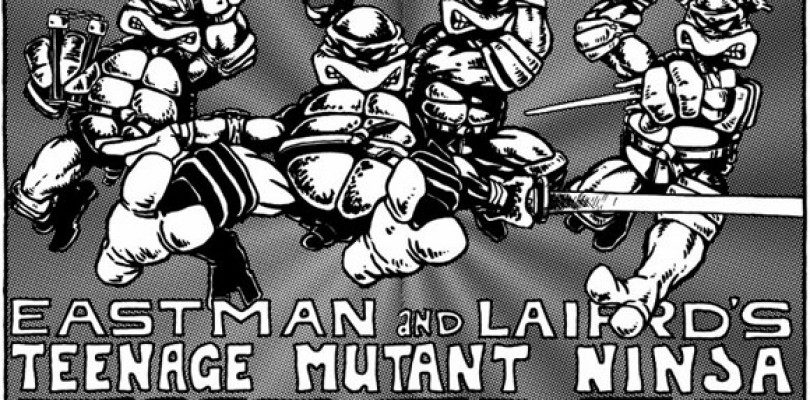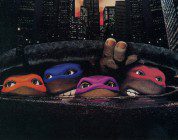30 years ago, Kevin Eastman and Peter Laird created a comic that not only started the black-and-white indie comic boom, but also grew into a global phenomenon that has consistently managed to succeed. And with a brand new film coming, I figured it’s time to talk about the Heroes in a Half-Shell, in their multiple forms, to see why it has continued to thrive from generation to generation. First stop, the comics.
The original book
It was an insane concept that never should have worked, but somehow did. Eastman and Laird, in their little apartment studio (hence the name Mirage Studios, because they weren’t really a studio), put together a single issue. The premise: four teenage mutant turtles (Leonardo, Raphael, Donatello and Michelangelo) trained in the combative arts of ninjutsu, after fighting and killing a street gang, learn from their teacher/adoptive father, a rat named Splinter, of their origins. Said origins involve the murder of Splinter’s owner, ninja Hamato Yoshi, by Oroku Saki, alias the Shredder, and the transformation of Splinter and his turtles by a strange glowing ooze into mutants. Splinter has trained his students for one reason: to kill the Shredder to avenge Yoshi. The Turtles send a message, calling out Shredder, who is not just a ninja leader of the Foot clan, but a major crime lord in New York. What follows is an epic, bloody battle on a rooftop between the Turtles and the Foot, ending with Leonardo running the Shredder through with his sword. The Turtles offer Saki a chance to regain honor through ritual suicide, but Shredder chooses instead to detonate a bomb and take them with him. The Shredder is thrown off the roof, dies in the explosion, and the Turtles disappear into the night. Whether it was just from the insane concept, the dark artwork, or the gritty story, the book sold like crazy, and suddenly, what was a one-shot book would explode into a major indie series.
The Mirage Comic series
Eastman and Laird wasted no time in building from that single issue, introducing new characters and plot elements, like April O’Neil, Casey Jones, Baxter Stockman, the benevolent alien Utroms (whose experiments resulted in the ooze that created the Turtles), as well as the return of the Shredder and the Foot Clan. The stories went out there, alternating between martial arts stories, supernatural horror stories, travels to outer space and time travel. One of my favorites was the Return to New York arc, where the Turtles faced the Shredder for the last time, ending with Leo beheading the Shredder. This was probably part of the series’ charm, since you never knew where it was going to go. It also helped that the Turtles, who really didn’t stand out from each other in the initial issue, were fleshed out to the archetypes we now associate with them: honorable warrior Leonardo, aggressive hothead Raphael, scientific genius Donatello, and laid-back Michelangelo. And when the book started to get big, and the cartoon started, Eastman and Laird brought in new writers and artists, giving a lot of people their big break. This gave the book a more anthology feel, turning off long-time fans. Eventually, Eastman and Laird returned to do the final story of Volume 1, City at War, a 13-part epic that tied all the loose ends up following Shredder’s death. Volume 2 would become a full-color series by Jim Lawson, continuing the story from Volume 1, but would be cancelled after a year due to low sales in 1995. Volume 3 would be released through Image Comics, and saw major changes, with Splinter becoming a bat, Raph becoming the Shredder, and Donnie becoming a cyborg. When this volume was cancelled in 1999, the events in it were stricken from canon. In 2001, Peter Laird brought back the Turtles in Volume 4, setting it 15 years after Volume 2. The gang were older, maybe wiser, and now the Utroms had opened trade with Earth, allowing the Turtles to pose as aliens and walk the streets in public, as they dealt with new threats, helping Casey and April raise their adopted daughter, and the eventual passing of Splinter due to old age. The book was ended in 2010, with a possibility of continuation in the contract when Mirage Studios sold the franchise to Paramount. The book is still regarded as a major piece of pop culture, and with reprints now more available than ever, fans have a new chance to relive the classic comic adventures of the Teenage Mutant Ninja Turtles.
Tales of the Teenage Mutant Ninja Turtles
Technically, this is part of the Mirage Studios’ franchise, but it deserves mention. This book worked as a companion-anthology book to the main book, opening with a splash page of a major character setting up the story, and the page would end with the ominous words “Let me tell you a story…” The book basically was used as a way to tell stories in different periods of the Turtles continuity, like flashback tales or stories set later on, and introduce new plot elements and fix plot issues from the main book. Several characters who would make a big impact in the main books appeared here, like the vigilante Nobody, or series favorites Leatherhead and Rat King, who would go on to appear in nearly every Ninja Turtles show and comic after this. The first volume lasted from 1987 to 1989, and the second volume would last from 2005 to 2010. My favorite was the storyline Loops, where the teenage Leonardo was forced to team up with his childhood self, as well as his 30 year-old and 100 year-old self to help a cosmic being in Ancient Egypt. It was a fun book, with a lot of creepy elements. It’s also available in collected forms, so again, check it out if you’re interested.
Teenage Mutant Ninja Turtles Adventures aka the Archie Comics series
Running from 1988 to 1995, this book initially started as an adaption comic of the 1987 animated series, but quickly became its own thing, helped along by the writers and artists who came to it from Mirage Studios. The book allowed the Turtles to go in interesting directions, allowing them to travel across Asia, the Pacific, the future, and beyond, touching on social and environmental issues in a non-preachy way. The series introduced a lot of new characters, like Raph’s ninja wolf girlfriend Ninjara, the Mighty Mutanimals (a spin-off team of mutants like Leatherhead, Slash, Wingnut and Screwloose), and with its comfortable middle-ground between the original comics’ maturity and the cartoon’s kid-friendly style, the Archie series is considered by some to be the best incarnation of the TMNT.
Dreamwave series
Appearing in 2003 as a tie-in to the second cartoon, this book, like the Archie one, started off as an adaption of that animated series before starting to venture into its own storyline. Unfortunately, Dreamwave comics went bankrupt due to bad business practices, leading to its cancellation after only 7 issues. Sadly, there’s not much to say beyond that, due to how short it was.
IDW series
So, what happens if you make a TMNT comic that combined major elements from the entire franchise? What if you included characters and elements from the Mirage books and all the animated series? What if you made it so that Splinter was just a mutated rat, but was also Hamato Yoshi like in the 80’s cartoon? That’s essentially this comic series, a grand tribute to the entire franchise while also being really original. Here, Hamato Yoshi was a ninja master in Feudal Japan, who was murdered, along with his four sons, by the evil Shredder. Yoshi and his sons find themselves reincarnated as a rat and four turtles, all being experimented on by Baxter Stockman for the alien Utrom warlord Krang. When they mutate, the newly-reunited family find allies in April, Casey, Professor Honeycutt the Fugitoid (a major character from the Mirage series) and the Neutrinos (from the 80’s cartoon), as they find themselves caught in the conflicted between the mystically resurrected Shredder and the evil alien Krang, with the fate of the Earth in their hands. It’s still ongoing, and really really good. Read this as soon as you can, whether you’re a longtime fan like me, or a new person.
That’s it for the comics. Watch this space for Part 2, where I’ll cover the various television series based on the Teenage Mutant Ninja Turtles.



